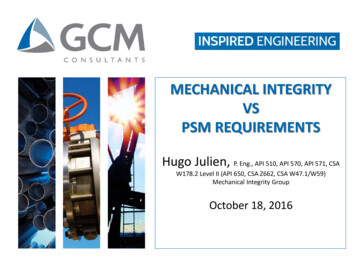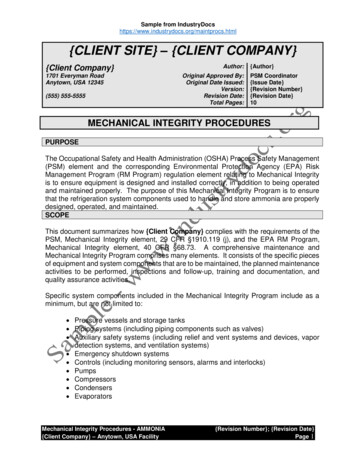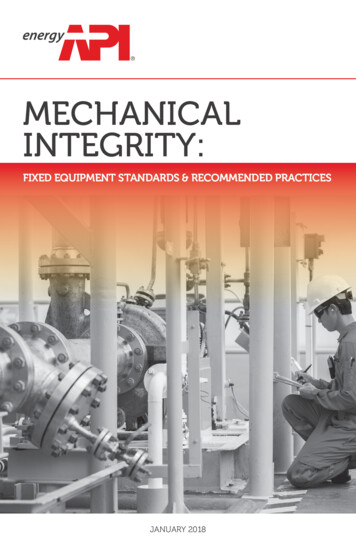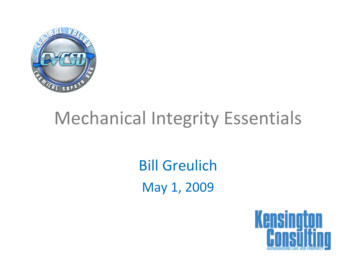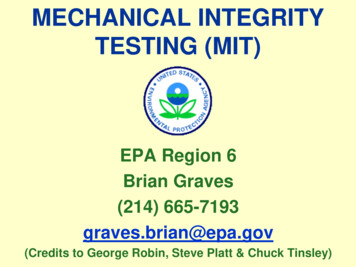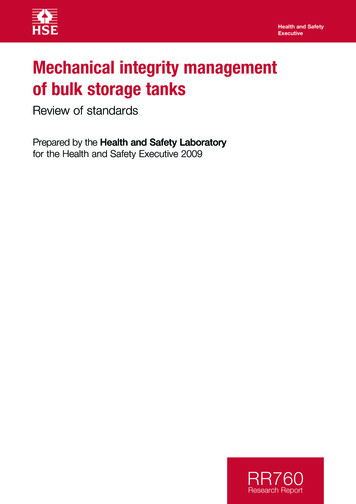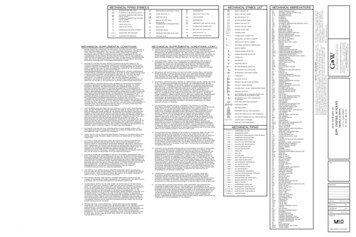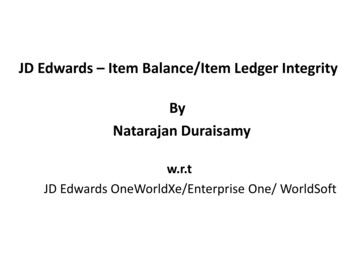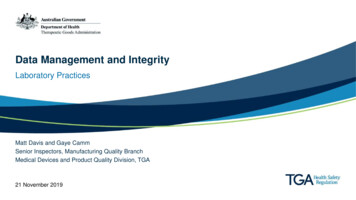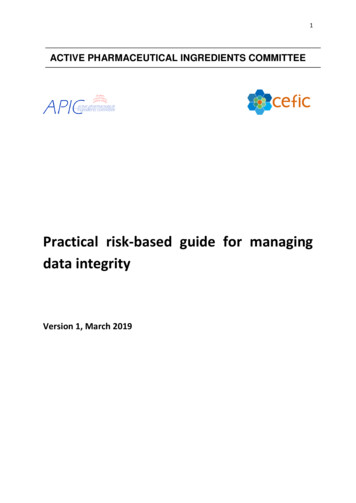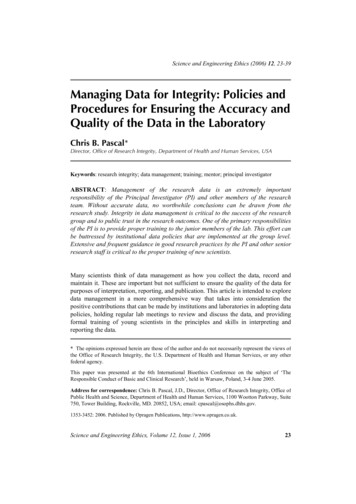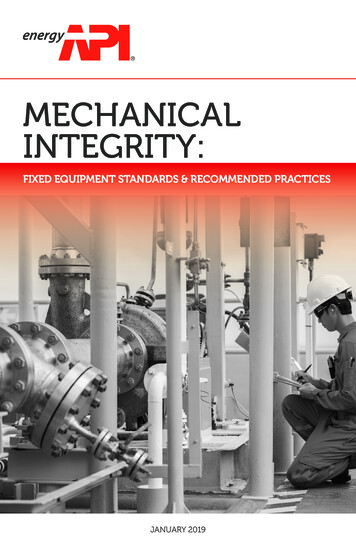
Transcription
MECHANICALINTEGRITY:FIXED EQUIPMENT STANDARDS & RECOMMENDED PRACTICESJANUARY 2019
CONTENTSAN INTRODUCTION TO MECHANICAL INTEGRITY:FIXED EQUIPMENT.2EQUIPMENT.5Pressure Vessels.5Piping Systems.6Heat Transfer Equipment.8Storage Tanks. 11Pressure Relief Devices.14PROCESSES.16Risk-Based Inspection.16Fitness-For-Service. 17Damage Mechanisms.18Integrity Operating Windows. 20CORROSION AND MATERIALS.21Welding.21Corrosion. 22TIMELINE OF FIRST EDITIONS OF API MECHANICALINTEGRITY STANDARDS & RPs.27OTHER NON-API MECHANICALINTEGRITY RESOURCES.31UPCOMING EVENTS.32MECHANICAL INTEGRITY: FIXED EQUIPMENT STANDARDS & RECOMMENDED PRACTICES1
AN INTRODUCTION TO MECHANICALINTEGRITY: FIXED EQUIPMENTMechanical Integrity (MI) can be defined as the management of criticalprocess equipment to ensure it is designed and installed correctly and thatit is operated and maintained properly. MI is 1 of the 14 elements included inthe OSHA Process Safety Management standard. MI includes equipment/assetssuch as pressure vessels, storage tanks, piping systems, and associated hardware(valves, fittings, etc.), relief devices, and emergency shutdown/control systemsMI encompasses the activities necessary to ensure that equipment/assetsare designed, fabricated, installed, operated and maintained in a way thatprovides the desired performance in a safe, environmentally protected,and reliable fashion.In the early 1900s, the need to protect workers and the public from the hazardsof boilers and pressurized equipment became apparent, so the industry beganto develop design standards. After World War II, a number of industryconsensus standards were developed by the National Board Inspection CodeTIMELINE OF IMPORTANT MI EVENTSAPI RP 750 Managementof Process Hazards . . . . . . 1991 1984 19901958API 510 - Pressure VesselInspection CodeBhopal DisasterAPI Std 653 -Tank Inspection, Repair,Alteration, and ReconstructionMECHANICAL INTEGRITY: FIXED EQUIPMENT STANDARDS & RECOMMENDED PRACTICES2
(NBIC). By the 1980s, the American Petroleum Institute (API) ledindustry efforts to develop and implement important MI standards,while the federal government also turned its regulatory attention to MI.API, industry, and the regulators have addressed MI head-on since theearly-90s, particularly through the Occupational Safety and HealthAdministration’s (OSHA) Process Safety Management (PSM) programand the Environmental Protection Agency’s (EPA) Risk ManagementProgram (RMP), as well as many additional Standards and RecommendedPractices (RPs) published by API.API and AFPM jointly manage the Advancing Process Safety Initiativewhich is a joint effort to further advance process safety improvements inrefineries and petrochemical plants by providing industry with moreopportunities to communicate and share experiences and knowledge.Through this partnership, API and AFPM collect process safetyperformance metrics, share process safety event information, produceand share Practices Sharing and Hazard Identification documents, hostRegional Networks meetings, address issue-specific topics such asOSHA PSMFinal RuleChemicalSafety Boardformed API 570 - PipingInspection Code API Publ 581 Risk-Based Inspection Base Resource Document 2010 OSHA RefineryNational EmphasisProgram Effective Date 2012 2007 2000 1993 2006Baker PanelRefinerySafety Review199819991992 API &AFPMAdvancingProcessSafetyProgramsfoundedEPA Risk ManagementProgram Final RuleFirst API SiteAssessmentMECHANICAL INTEGRITY: FIXED EQUIPMENT STANDARDS & RECOMMENDED PRACTICES3
Mechanical Integrity and Human Reliability. API also operates a programthat assesses a site’s Process Safety systems using independent and crediblethird party teams of industry-qualified process safety expert assessors. Throughthe use of industry developed protocols, the assessments evaluate both thequality of the written programs and the effectiveness of field implementation,including a site’s Mechanical Integrity program.API has taken an active role in the creation and propagation of MIinformation and materials. API committees create Standards and RPs thataddress MI, largely in the areas of inspection and repair of pressure vessels,aboveground storage tanks, equipment reliability, corrosion, mechanics,and reducing capital and maintenance costs.These documents provide expectations on implementation and compliance,and many contain requirements in the form of “shall” statements, as determinedby industry consensus committees. The creation of these industry-wide standardsallows for procedures and practices to seamlessly continue at a company despitechallenges presented by a dynamic and changing workforce. Institutionalknowledge is no longer limited to a few senior employees, and “gut feeling” isreplaced with tried-and-true methods contained in the Standards and RPs.Because they must be applicable to many different sites, API committees writetheir documents in a way that still allows managers to operate in the most safeand efficient manner as dictated by their own facility’s needs.The motivation for writing API MI Standards and RPs was based on safety,competition, and budgeting challenges, as well as myriad external pressures, butthe adoption of these documents has led to more valuable inspection data,increased ability to handle changing process conditions, and the scheduling andbudgeting benefit of planned inspections, among other things. API Standardsand RPs are periodically reviewed so that they remain relevant and valuable tothe industry, and a review of past standards and updates shows how well theindustry has adapted to changing times and MI science.This brochure is designed to acquaint the reader with the MI resources availablein API Standards, Recommended Practices, and other helpful resources. Theinformation is organized topically, and “companion” documents meant tocomplement one another are highlighted and listed together.MECHANICAL INTEGRITY: FIXED EQUIPMENT STANDARDS & RECOMMENDED PRACTICES4
EQUIPMENTPressure VesselsAPI 510Pressure Vessel Inspection Code: In-Service Inspection, Rating, Repair,and Alteration(Includes Addendum 1 (2017) and Addendum 2 (2018))Covers the in-service inspection, repair, alteration, and rerating activities forpressure vessels and the pressure-relieving devices protecting these vessels.This inspection code applies to most refining and chemical process vessels thathave been placed in service. This includes: vessels constructed in accordance with an applicable construction code; vessels constructed without a construction code (non-code)—a vessel not fabricatedto a recognized construction code and meeting no known recognized standard; vessels constructed and approved as jurisdictional special based upon jurisdictionacceptance of particular design, fabrication, inspection, testing, and installation; non-standard vessels—a vessel fabricated to a recognized construction codebut has lost its nameplate or stamping.Companion document to RP 57210th Edition May 2014RP 572Inspection Practices for Pressure VesselsSupplements API 510 by providing pressure vessel inspectors with information thatcan improve skills and increase basic knowledge of inspection practices. Thisrecommended practice (RP) describes inspection practices for the various types ofpressure vessels (e.g. drums, heat exchangers, columns, reactors, air coolers, spheres)used in petroleum refineries and chemical plants. This RP addresses vessel components,inspection planning processes, inspection intervals, methods of inspection andassessment, methods of repair, records, and reports. API 510 has requirements andexpectations for inspection of pressure vessels.Companion document to API 5104th Edition December 2016MECHANICAL INTEGRITY: FIXED EQUIPMENT STANDARDS & RECOMMENDED PRACTICES5
Piping SystemsAPI 570Piping Inspection Code: In-Service Inspection, Rating, Repair, and Alterationof Piping Systems(Includes Addendum 1 (2017) and Addendum 2 (2018))Covers inspection, rating, repair, and alteration procedures for metallic andfiberglass reinforced plastic (FRP) piping systems and their associated pressurerelieving devices that have been placed in service. This inspection code applies toall hydrocarbon and chemical process piping covered in 1.2.1 that have beenplaced in service unless specifically designated as optional per 1.2.2. Thispublication does not cover inspection of specialty equipment includinginstrumentation, exchanger tubes, and control valves.However, this piping code could be used by owner/users in other industries and otherservices at their discretion. Process piping systems that have been retired from serviceand abandoned in place are no longer covered by this “in-service inspection” Code.However abandoned in place piping may still need some amount of inspection and/orrisk mitigation to assure that it does not become a process safety hazard because ofcontinuing deterioration. Process piping systems that are temporarily out of service buthave been mothballed (preserved for potential future use) are still covered by this Code.Companion document to RP 5744th Edition February 2016RP 574Inspection Practices for Piping System ComponentsSupplements API 570 by providing piping inspectors with information that canimprove skill and increase basic knowledge of inspection practices. Thisrecommended practice describes inspection practices for piping, tubing, valves(other than control valves), and fittings used in petroleum refineries and chemicalplants. Common piping components, valve types, pipe joining methods,inspection planning processes, inspection intervals and techniques, and types ofrecords are described to aid the inspectors in fulfilling their role implementingAPI 570. This publication does not cover inspection of specialty items, includinginstrumentation, furnace tubulars, and control valves.Companion document to API 5704th Edition November 2016MECHANICAL INTEGRITY: FIXED EQUIPMENT STANDARDS & RECOMMENDED PRACTICES6
RP 578Guidelines for a Material Verification Program (MVP) for New and Existing AreasProvides the guidelines for a material and quality assurance system to verify that thenominal composition of alloy components within the pressure envelope of a pipingsystem is consistent with the selected or specified construction materials to minimizethe potential for catastrophic release of toxic or hazardous liquids or vapors.This RP provides the guidelines for material control and material verificationprograms on ferrous and nonferrous alloys during the construction, installation,maintenance, and inspection of new and existing process piping systems coveredby the ASME B31.3 and API 570 piping codes. This RP applies to metallic alloymaterials purchased for use either directly by the owner/user or indirectly throughvendors, fabricators, or contractors and includes the supply, fabrication, anderection of these materials. Carbon steel components specified in new or existingpiping systems are not specifically covered under the scope of this documentunless minor/trace alloying elements are critical to component corrosionresistance or similar degradation.3rd Edition February 2018MECHANICAL INTEGRITY: FIXED EQUIPMENT STANDARDS & RECOMMENDED PRACTICES7
Heat Transfer EquipmentStd. 530Calculation of Heater-Tube Thickness in Petroleum RefineriesSpecifies the requirements and gives recommendations for the procedures anddesign criteria used for calculating the required wall thickness of new tubes andassociated component fittings for fired heaters for the petroleum, petrochemical,and natural gas industries. These procedures are appropriate for designing tubesfor service in both corrosive and non-corrosive applications. These procedureshave been developed specifically for the design of refinery and related fired heatertubes (direct-fired, heat-absorbing tubes within enclosures). These procedures arenot intended to be used for the design of external piping. This standard does notgive recommendations for tube retirement thickness; Annex A describes atechnique for estimating the life remaining for a heater tube.7th Edition April 2015RP 538Industrial Fired Boilers for General Refinery and Petrochemical ServiceSpecifies requirements and gives recommendations for design, operation, maintenance,and troubleshooting considerations for industrial fired boilers used in refineries andchemical plants. It covers waterside control, combustion control, burner managementsystems (BMSs), feedwater preparation, steam purity, emissions, etc.1st Edition October 2015Std. 560Fired Heaters for General Refinery ServiceSpecifies requirements and gives recommendations for the design, materials, fabrication,inspection, testing, preparation for shipment, and erection of fired heaters, air preheaters(APHs), fans, and burners for general refinery service. Covered sections includePurchaser’s and Vendor’s Responsibilities; Design Considerations (Process, Combustionan
MECHANICAL INTEGRITY: FIXED EQUIPMENT STANDARDS & RECOMMENDED PRACTICES 2 AN INTRODUCTION TO MECHANICAL INTEGRITY: FIXED EQUIPMENT M echanical Integrity (MI) can be defined as the management of critical process equipment to ensure it is designed and installed correctly and that it is operated and maintained properly. MI is 1 of the 14 elements included in
